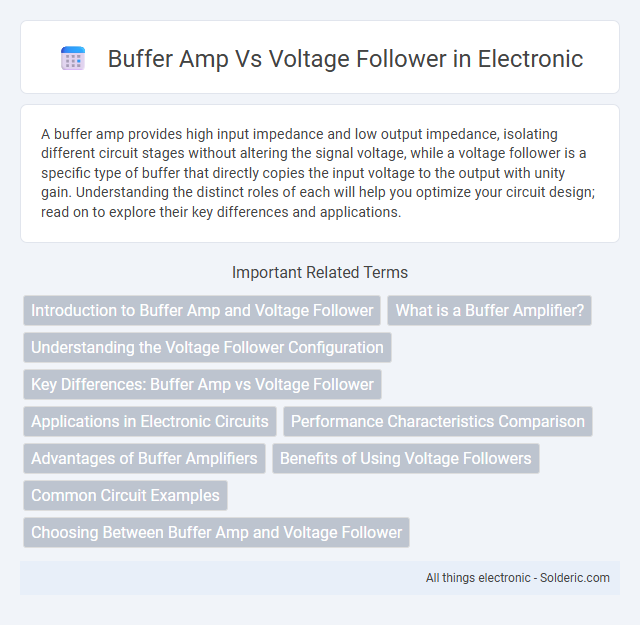A buffer amp provides high input impedance and low output impedance, isolating different circuit stages without altering the signal voltage, while a voltage follower is a specific type of buffer that directly copies the input voltage to the output with unity gain. Understanding the distinct roles of each will help you optimize your circuit design; read on to explore their key differences and applications.
Comparison Table
| Feature | Buffer Amplifier | Voltage Follower |
|---|---|---|
| Function | Impedance matching; isolates circuit stages | Unity gain amplifier; outputs the same voltage as input |
| Gain | Approximately 1 (unity) | Exactly 1 (unity) |
| Input Impedance | Very high, prevents loading of previous stage | Very high, prevents signal attenuation |
| Output Impedance | Very low, drives heavy loads | Very low, suitable for driving loads |
| Typical Application | Signal isolation; driving low impedance devices | Signal buffering; avoiding voltage drops in sensor circuits |
| Internal Configuration | Operational amplifier wired as voltage follower with buffering stage | Operational amplifier connected with output directly to inverting input |
Introduction to Buffer Amp and Voltage Follower
A buffer amplifier, often implemented as an operational amplifier configured for unity gain, provides high input impedance and low output impedance to isolate circuit stages without signal distortion. A voltage follower, a specific type of buffer amplifier, directly outputs the input voltage, maintaining signal integrity and preventing loading effects. Both devices are essential in analog circuits for impedance matching and signal buffering, ensuring accurate voltage transfer between components.
What is a Buffer Amplifier?
A buffer amplifier is an electronic device designed to isolate different stages of a circuit by providing high input impedance and low output impedance, ensuring signal integrity without loading the source. Unlike a voltage follower, which simply provides unity gain and follows the input voltage, a buffer amplifier may also offer gain while maintaining impedance matching. Your choice between these depends on the need for signal amplification or merely impedance isolation.
Understanding the Voltage Follower Configuration
The voltage follower configuration, also known as a buffer amplifier, provides a high input impedance and low output impedance, ensuring signal integrity without voltage gain. This configuration uses an operational amplifier where the output is directly connected to the inverting input, maintaining unity gain and preventing loading effects on the input source. Understanding this setup is crucial for applications requiring impedance matching and signal isolation.
Key Differences: Buffer Amp vs Voltage Follower
Buffer amplifiers and voltage followers serve similar functions by providing unity gain and high input impedance, but buffer amps often include additional current driving capability, making them suitable for isolating stages in a circuit. Voltage followers strictly replicate input voltage at the output with minimal phase shift and are primarily used to prevent loading effects, maintaining signal integrity. Your choice depends on whether you need simple voltage replication with minimal signal distortion or enhanced current drive and isolation features.
Applications in Electronic Circuits
Buffer amplifiers and voltage followers both serve to isolate different stages in electronic circuits, preventing loading effects and signal distortion. Buffer amps are commonly used in impedance matching, ensuring signals maintain strength when transferred between high-impedance sources and low-impedance loads. Your designs benefit from voltage followers when a unity gain stage is needed to drive subsequent circuit elements without altering the original voltage level.
Performance Characteristics Comparison
Buffer amplifiers and voltage followers both serve to isolate circuits, but buffer amps typically offer higher input impedance and better output drive capabilities, ensuring minimal signal loss and distortion. Voltage followers, a subset of buffer amps, provide unity gain with excellent linearity and low output impedance, making them ideal for impedance matching and signal buffering. Your choice depends on whether you prioritize stable voltage replication with minimal loading (voltage follower) or enhanced current driving performance (buffer amplifier).
Advantages of Buffer Amplifiers
Buffer amplifiers provide high input impedance and low output impedance, preventing signal source loading and ensuring signal integrity. They offer unity gain while isolating different circuit stages, which improves overall stability and reduces signal distortion. These characteristics make buffer amplifiers ideal for impedance matching and driving heavy loads without voltage drop.
Benefits of Using Voltage Followers
Voltage followers provide high input impedance and low output impedance, ensuring signal integrity by preventing loading effects on the source. They offer unity gain, making them ideal for impedance matching in sensitive analog circuits. These characteristics improve overall circuit stability and accuracy in applications like sensor signal conditioning and audio amplification.
Common Circuit Examples
The voltage follower, also known as a unity gain buffer, is a common buffer amplifier configuration where the output voltage directly follows the input voltage, providing high input impedance and low output impedance without gain. Buffer amps are frequently implemented in amplifier circuits such as impedance matching between stages, preventing signal loading, and isolating different parts of an electronic system. Your choice between a buffer amp and voltage follower depends on the specific requirement of signal integrity and load driving capability in applications like sensor interfacing or audio preamplifier design.
Choosing Between Buffer Amp and Voltage Follower
Choosing between a buffer amp and a voltage follower depends on the required input and output impedance characteristics; buffer amps typically offer high input impedance and low output impedance, ideal for impedance matching in complex circuits. Voltage followers, as a subset of buffer amplifiers, provide unity gain and are effective for signal isolation without amplification. Selecting the right device hinges on circuit demands such as gain requirements, signal integrity, and load driving capacity.
buffer amp vs voltage follower Infographic

 solderic.com
solderic.com